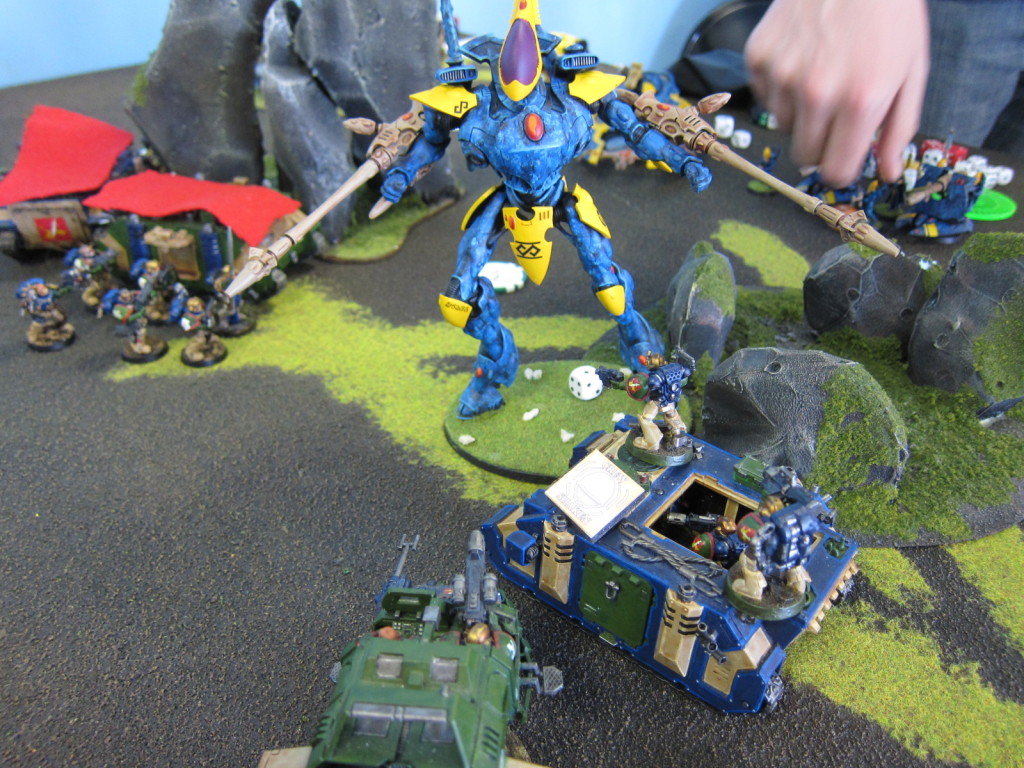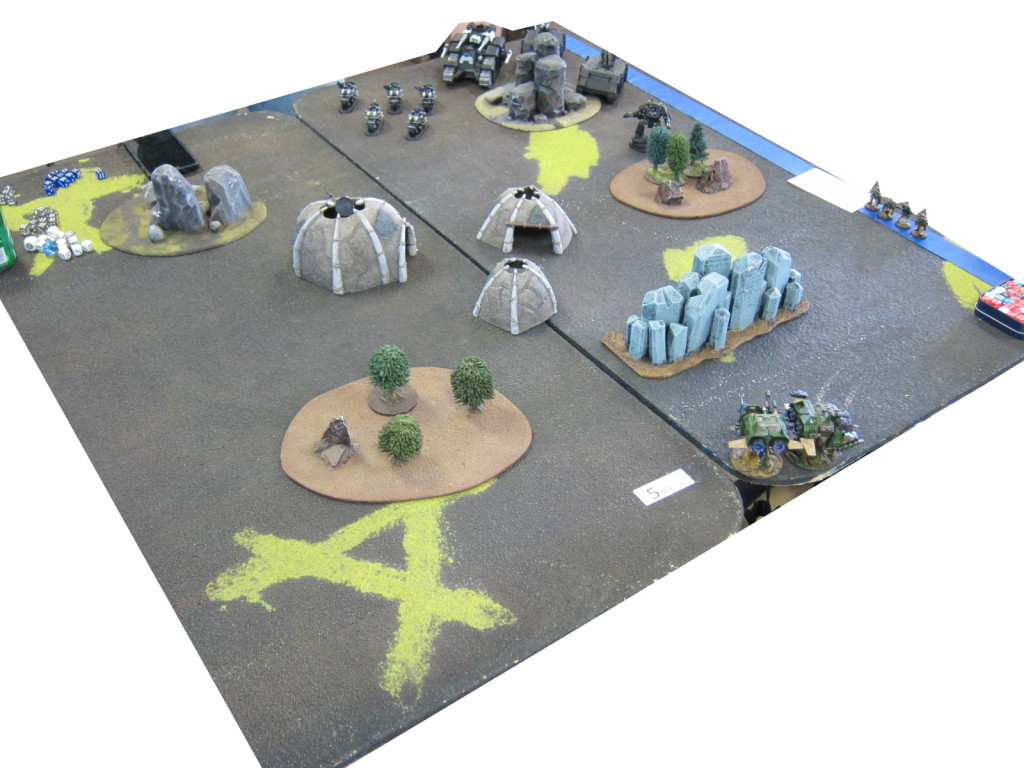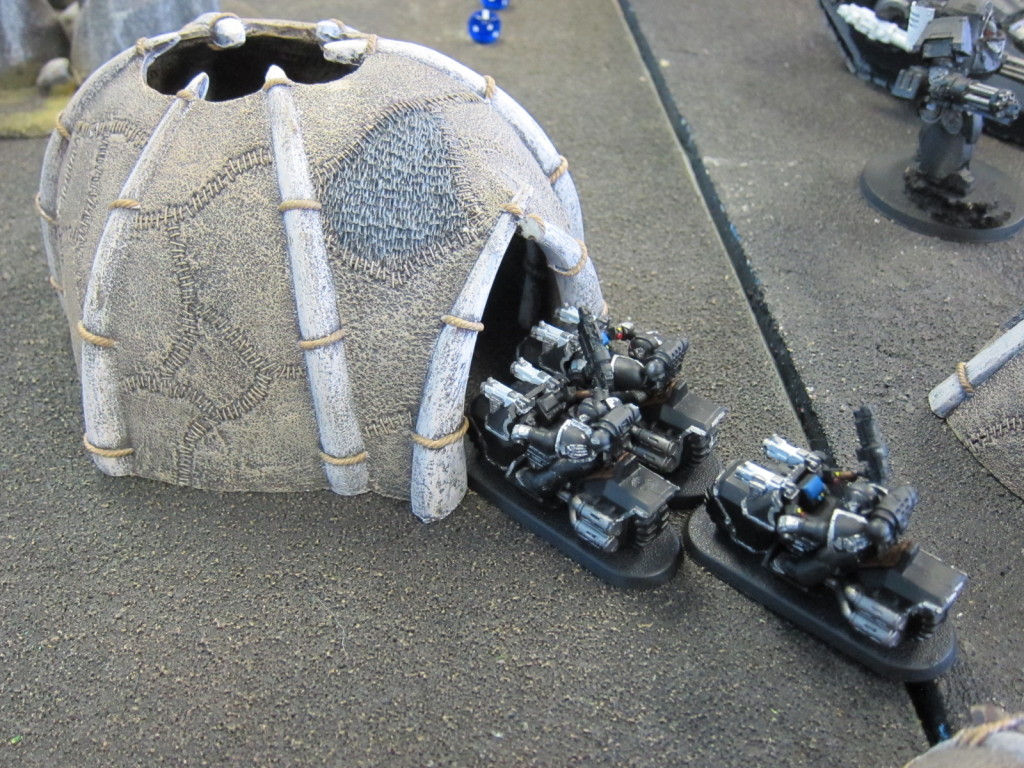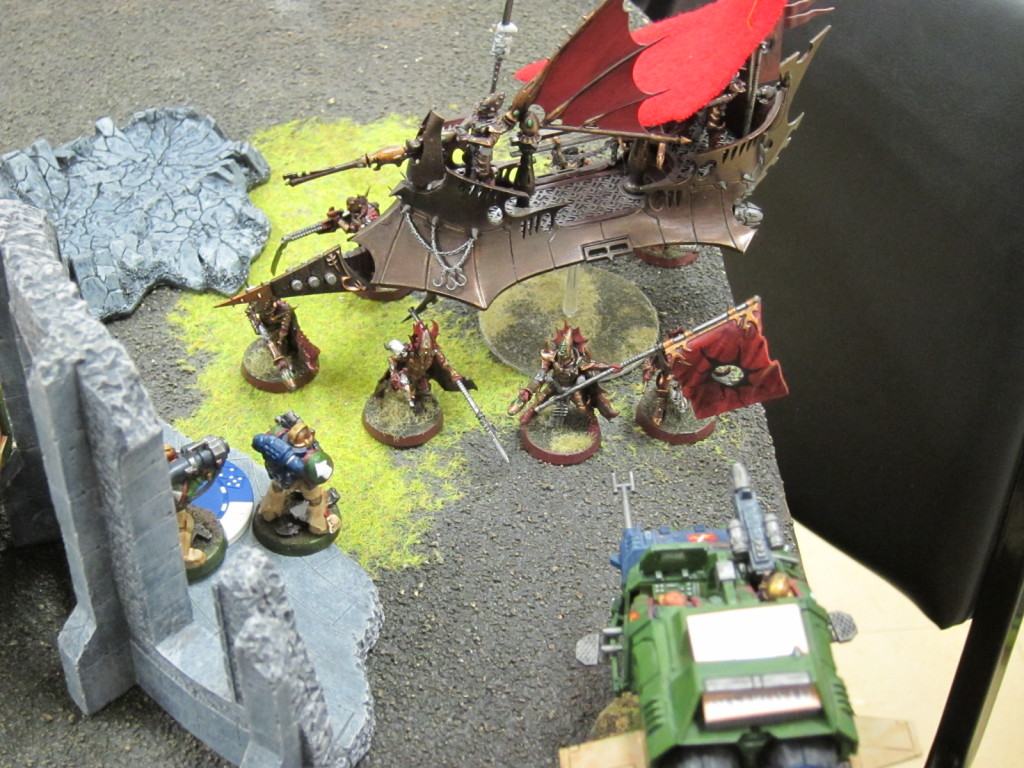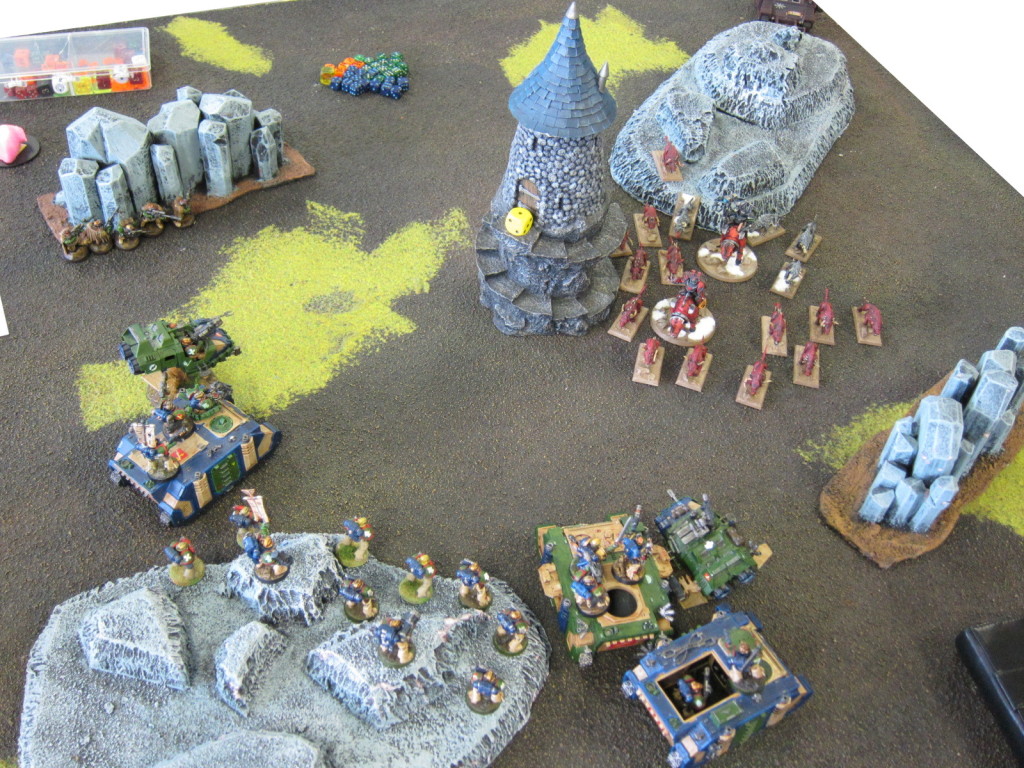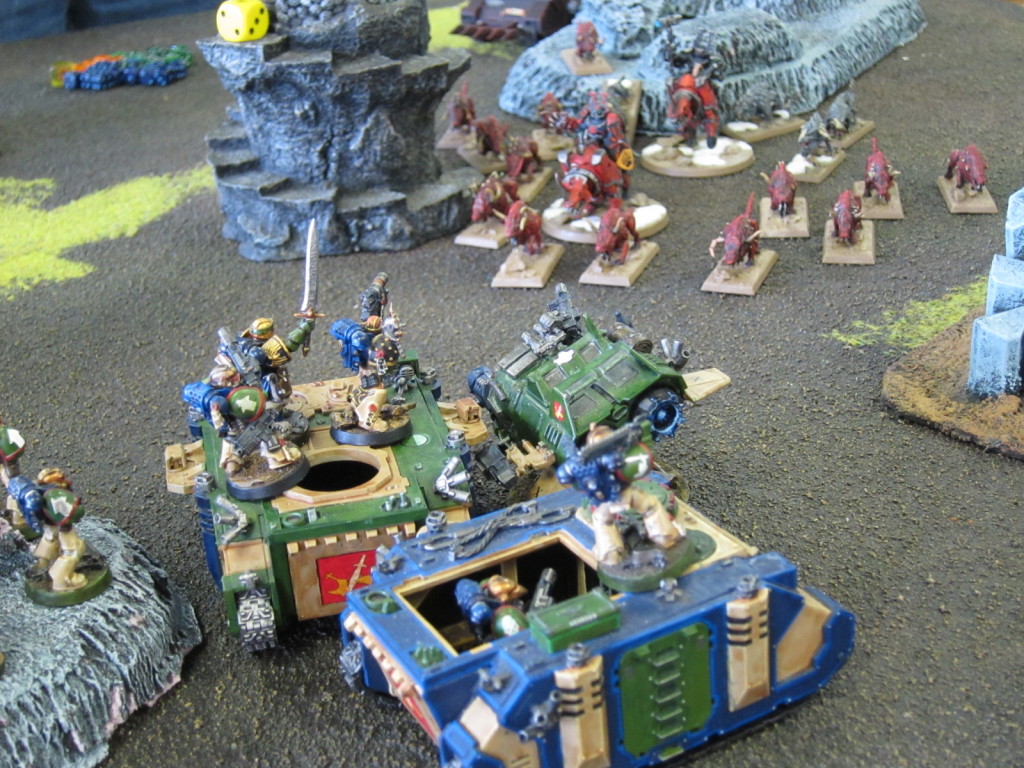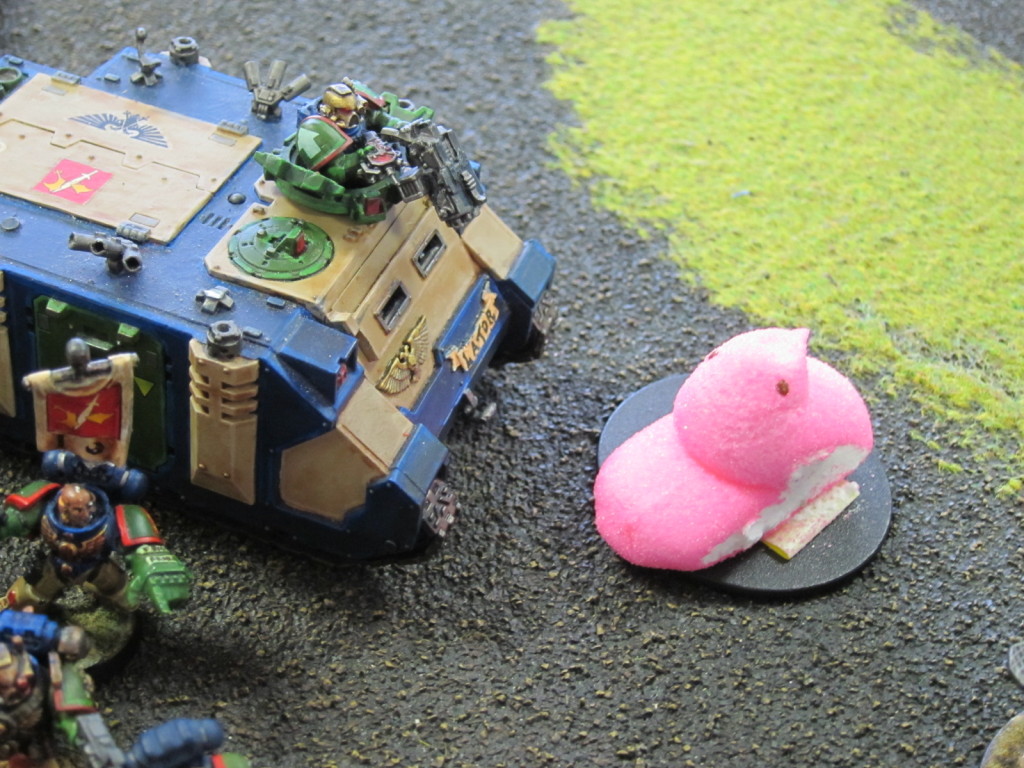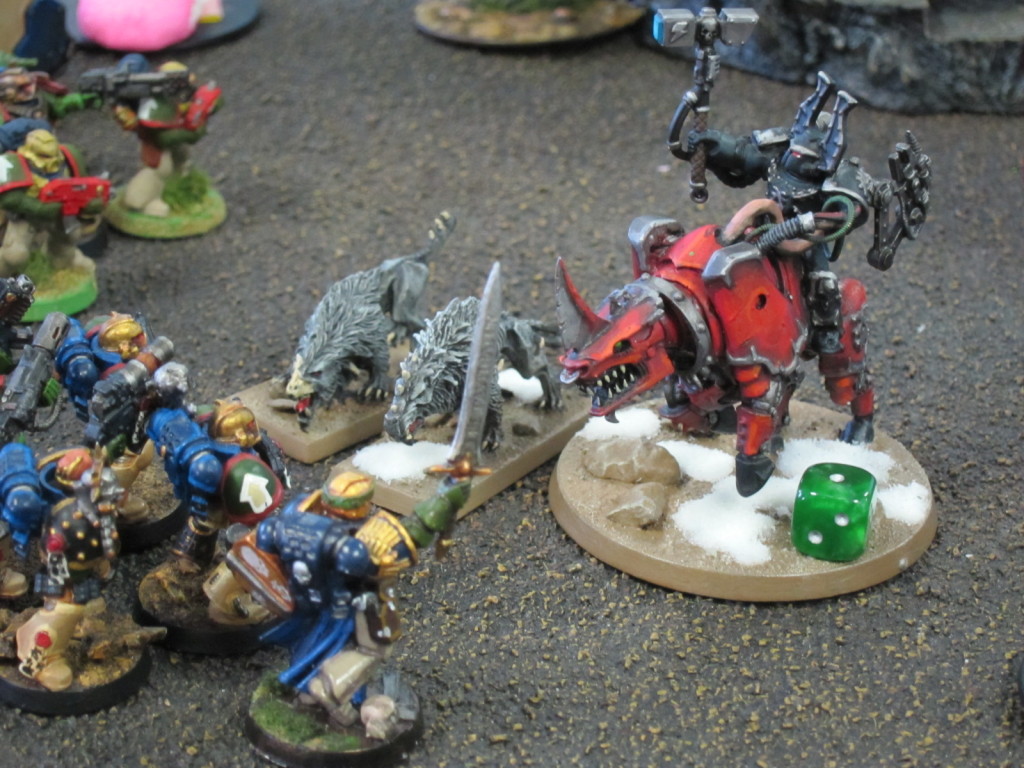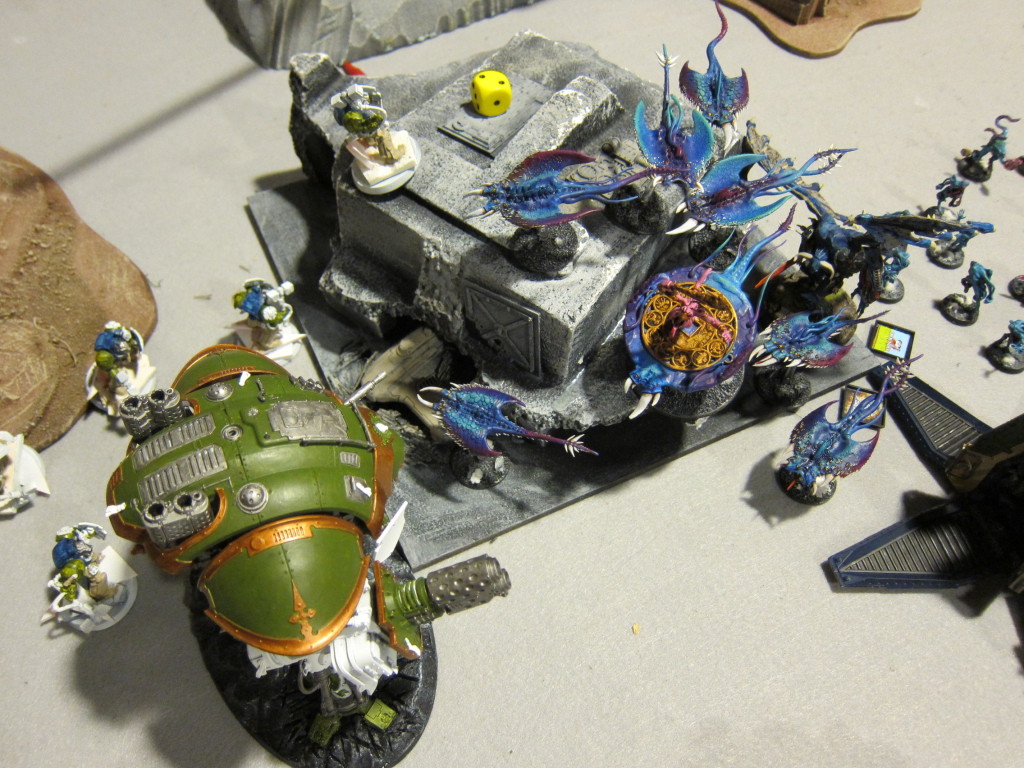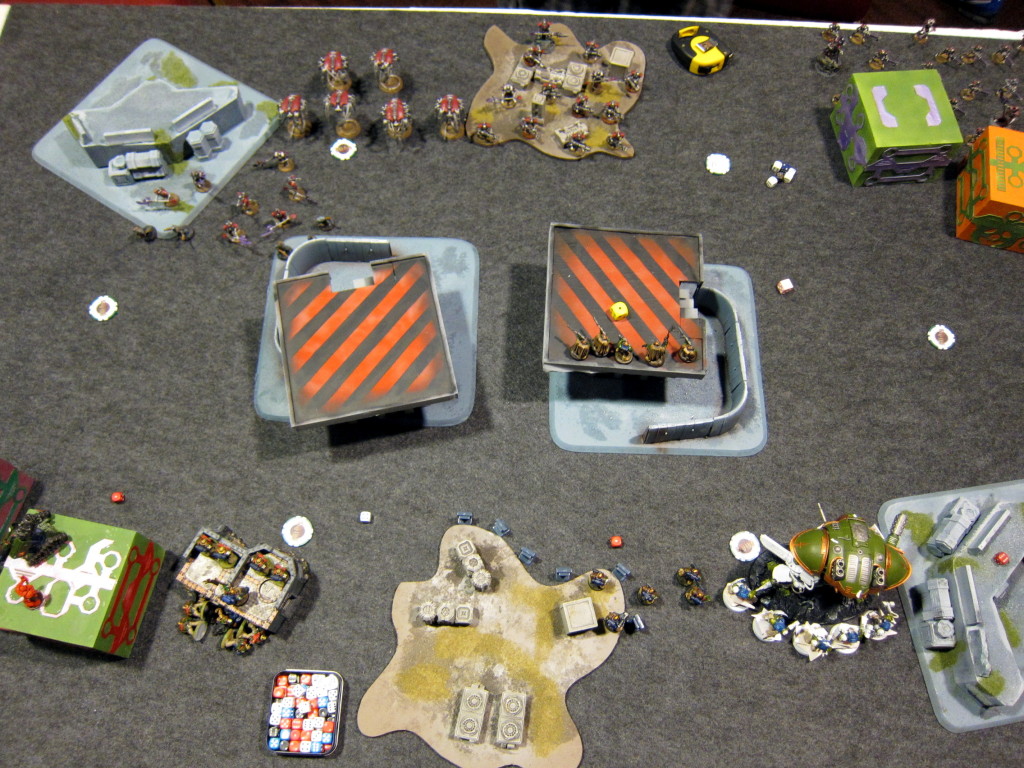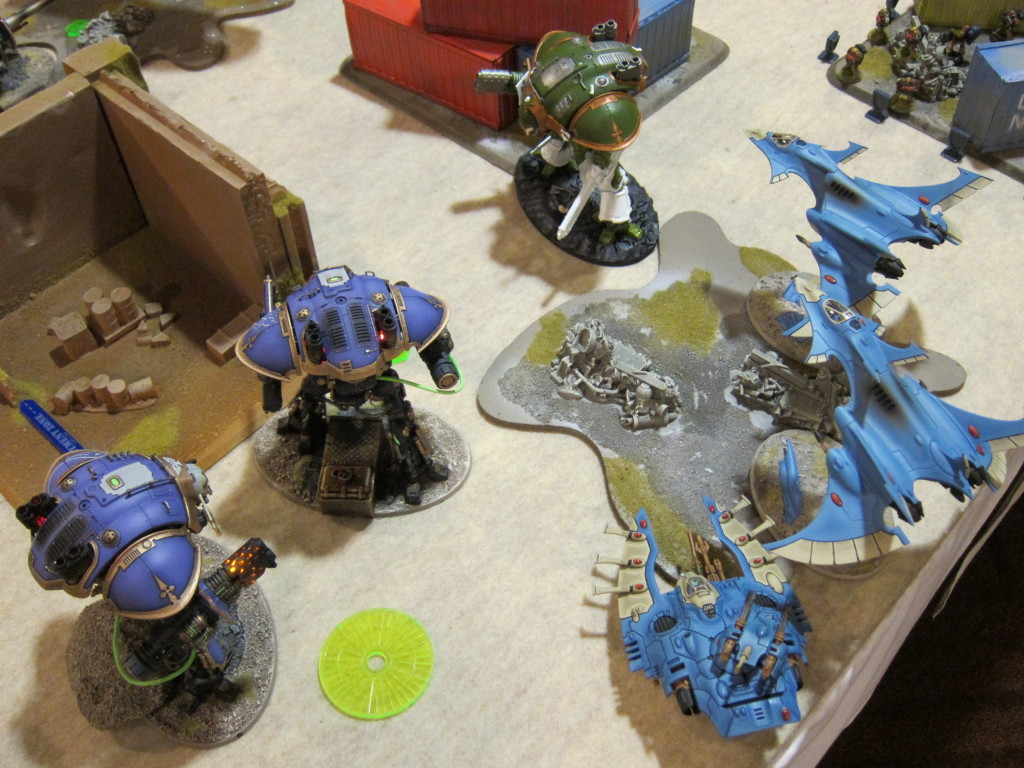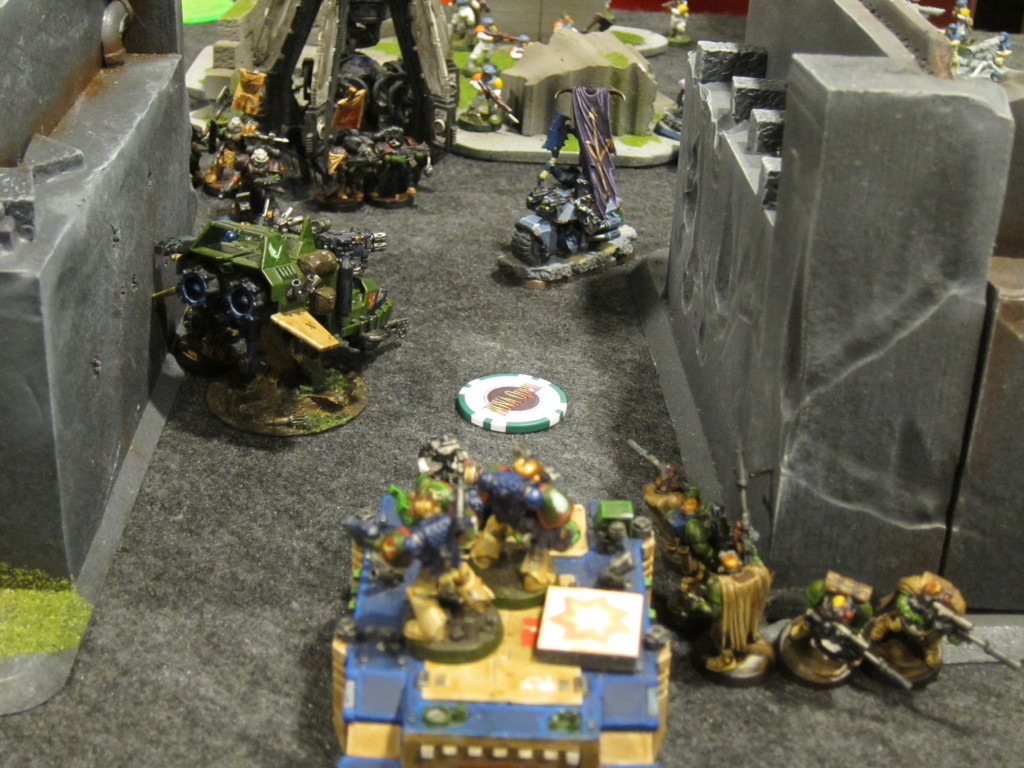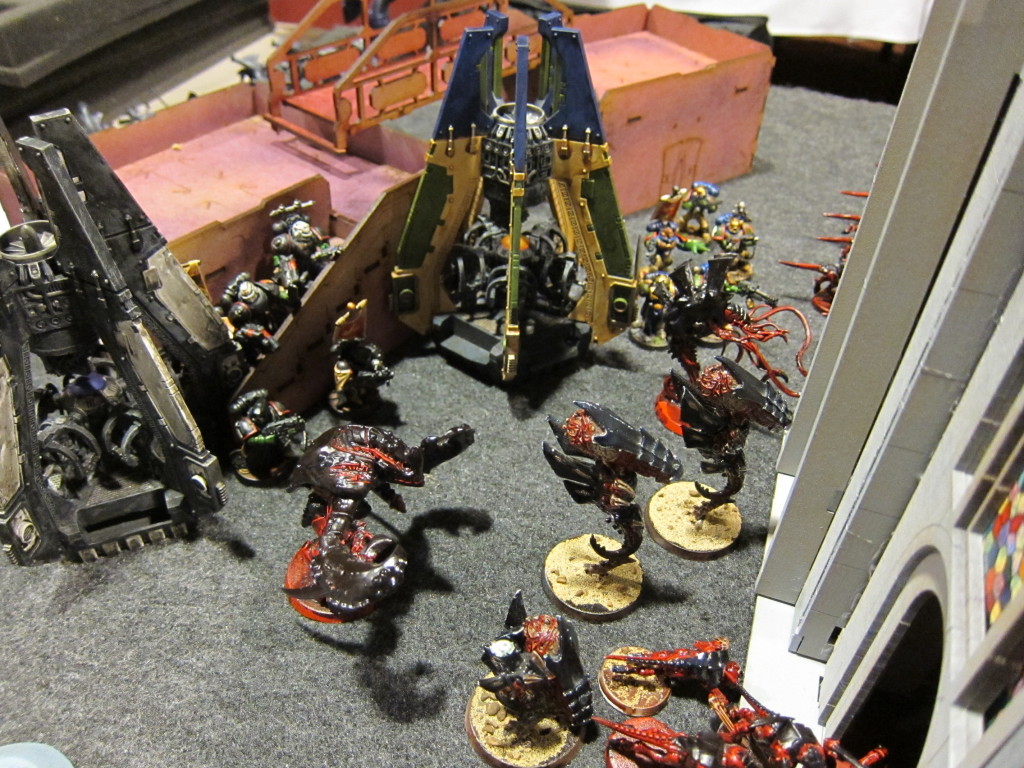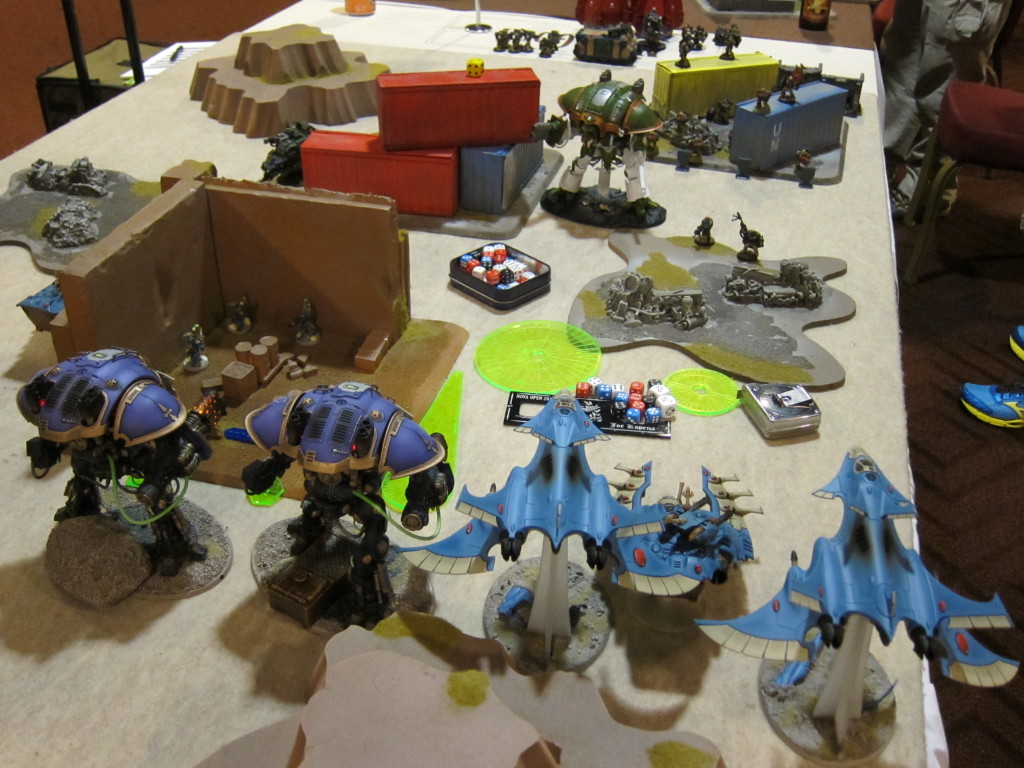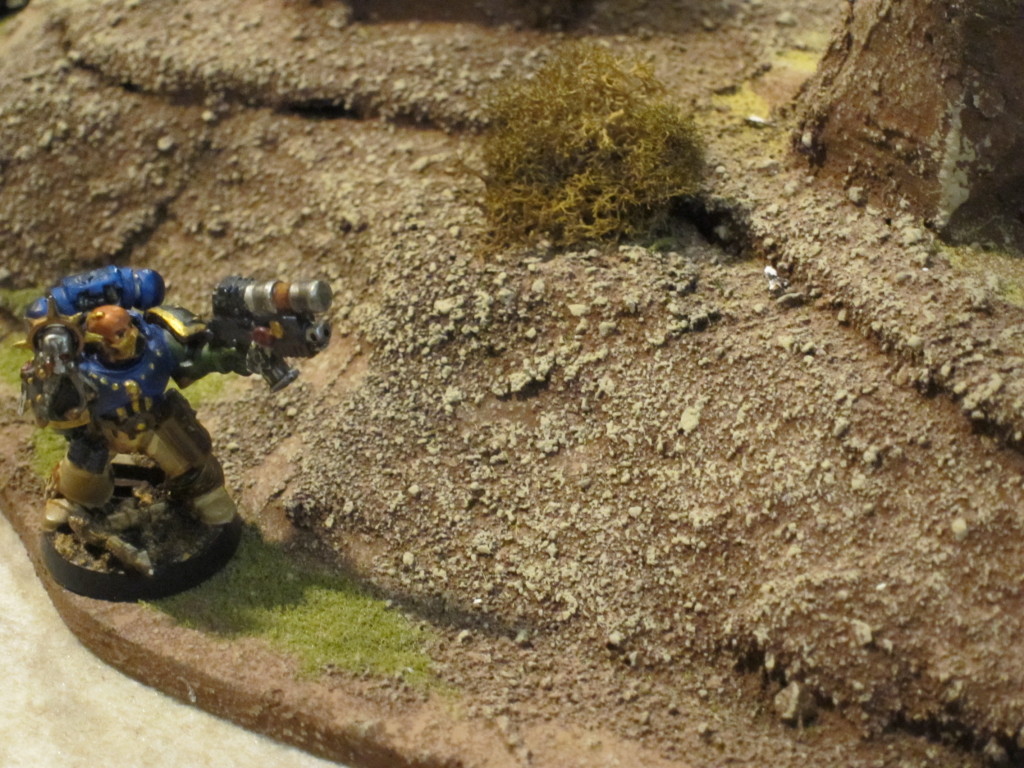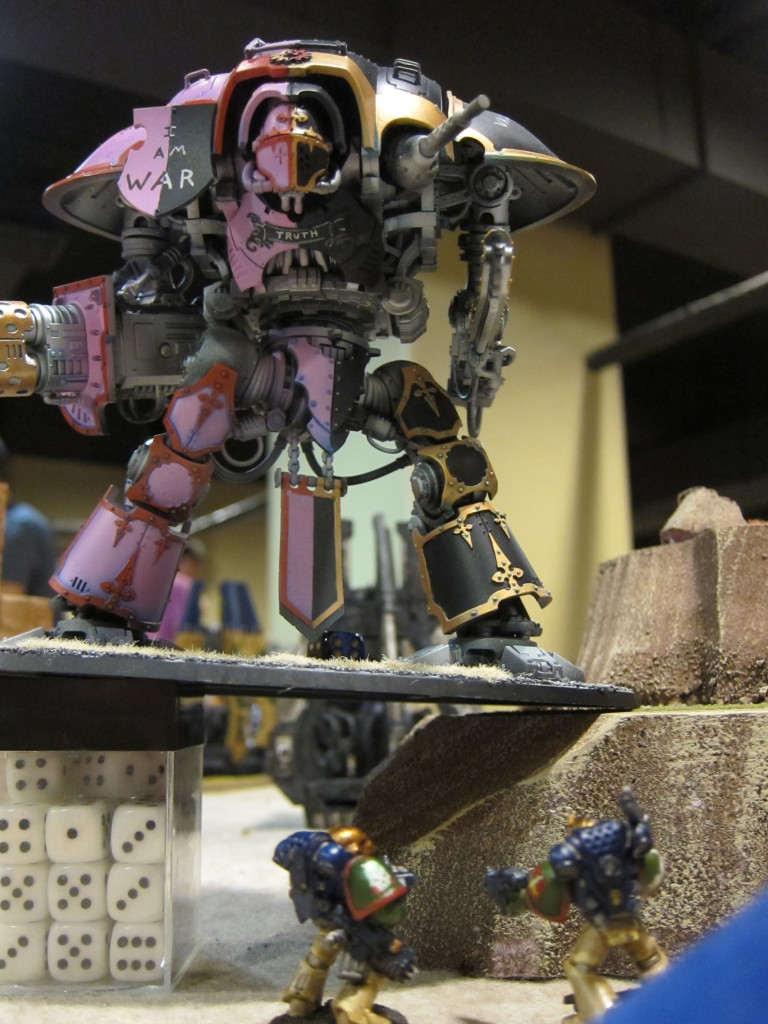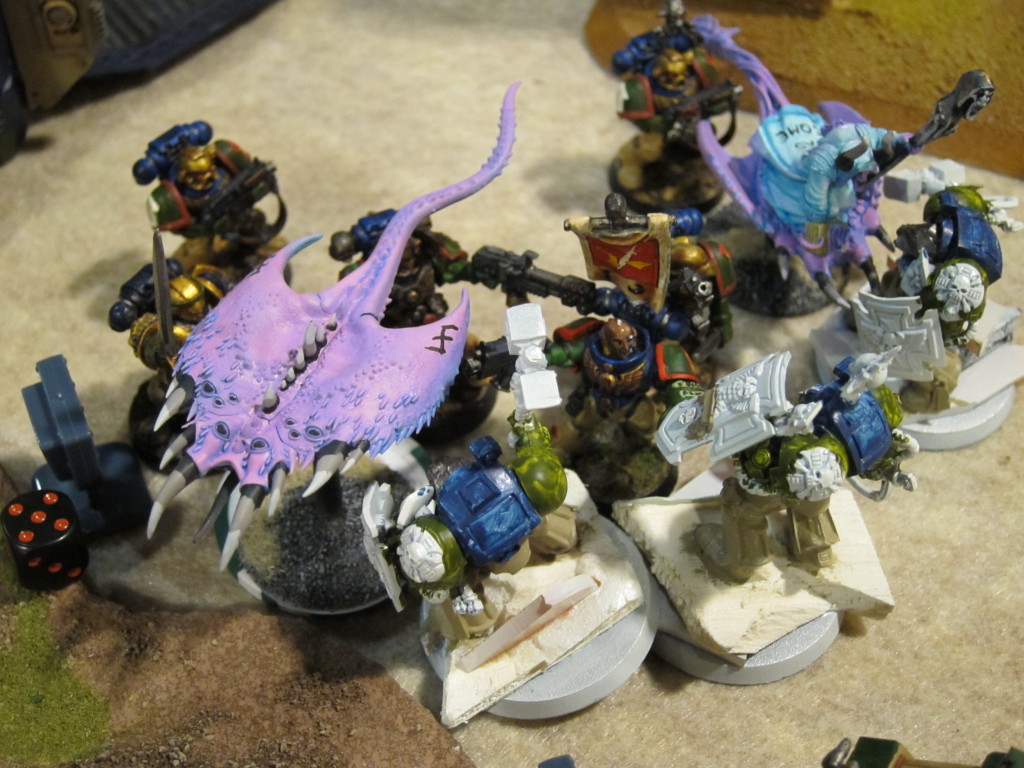 This weekend I went out for the Berks 40k Spring Assault in the Classic track, a 1000 point casual-oriented tournament. Unfortunately several other PAGE and Redcap’s people bailed at the last minute, but Tom M, Colin K, and Steve S were also there. The Classic track had 40 players, and the 2500 point Unleashed track another 16, so together with a bunch of organizers, judges, and spectators, there was a sizable crowd. This was actually my first time going to the Spring Assault, and I was not disappointed. Despite a couple rough games personally and winning absolutely zero of the many many raffle drawings, it was as expected a really fun day.
This weekend I went out for the Berks 40k Spring Assault in the Classic track, a 1000 point casual-oriented tournament. Unfortunately several other PAGE and Redcap’s people bailed at the last minute, but Tom M, Colin K, and Steve S were also there. The Classic track had 40 players, and the 2500 point Unleashed track another 16, so together with a bunch of organizers, judges, and spectators, there was a sizable crowd. This was actually my first time going to the Spring Assault, and I was not disappointed. Despite a couple rough games personally and winning absolutely zero of the many many raffle drawings, it was as expected a really fun day.
A few more photos from my games and just a couple of armies on display are in the photo gallery. Unfortunately there was enough going on all day, and my games busy enough, that I didn’t manage to get nearly as many photos as I usually do, particularly from the surrounding games and armies.
 Army
Army
I went with something atypical for me—no Drop Pods, no Sternguard, no Knight (not permitted in this format!), no fortification, just dudes in trucks and some skimmer supports:
- Captain Angholan (Vulkan)
- Squad Scolirus: Tactical x10 w/ Veteran Sgt, Powerfist, Flamer, Missile Launcher, Rhino
- Squad Harbinger: Tactical x6 w/ Veteran Sgt, Combi-Melta, Meltabombs, Meltagun, Rhino
- Squad Titus: Tactical x10 w/ Veteran Sgt, Chainsword, Meltabombs, Meltagun, Missile Launcher, Rhino
- Scouts x5 w/ Camo Cloaks, Sniper Rifles
- Landspeeder w/ Multi-Melta, Heavy Flamer
- Landspeeder w/ Multi-Melta, Heavy Flamer
That is a pretty traditional and fluffy Space Marine list, but has some units of dubious performance in the modern day. Landspeeders, particularly of this kit-out, are not super strong at the moment, to a large extent simply due to not getting the Salamanders’ flame re-rolls. But their high mobility can be useful in these kind of small games to grab objectives and such and I love them, so I went with it. Vulkan on the other hand is generally a very good unit for a combat-oriented Space Marine, he’s just a lot of points to sink into a single T4 infantry model at 1000pts.
The Rhinos I took over Drop Pods because I expected terrain to be slightly lighter than what we generally run, so I wanted something for my dudes to bunker up in. With such few units I was also worried about my ability to cover any Maelstrom type mission with dudes on foot after Podding in.
All in all, to foreshadow a bit, I wasn’t too shocked to struggle in two games against newer toys, and was pleased to do well in the other half of my games.
Round 1
Dawn of War, Crusade with 4 objectives, against Mark V H’s Eldar. His list had a good mix of units, I actually think it was originally designed for Highlander format as nothing repeated. I think it really hurt me this game to not have my usual Drop Pods and Sternguard. With the Pods I could have taken the fight directly to the xenos, potentially slagging his exposed D-Cannon artillery, and the Sternguard could have put poison and melta on the Wraithknight. As it was though, those barrage S10 AP2 shots tagged anything I did manage to hide from the walker and a Wave Serpent, with a Nightwing Interceptor coming in later to clean up. The Kingbreakers did take down the Wraithknight Aevethon’s Lament, but it was a pyrrhic victory just before they were swept away.
Round 2
Vanguard Strike, Purge the Alien with old school Victory Points (1 point for each 100 pts totaled among completely destroyed units), against Louis J and his Iron Hands. This kind of mission is always tough for me, and this seemed like just a particularly bad matchup for it. His army was a bit light on units, so playing for objectives I think I would have been fine. But for kill points all my light vehicles and troops rushing across a fairly open field at him seemed like they’d be tasty targets for his large quantity of S6+ long range shooting before I could get any melta into play: Dudes with lascannons, two Razorbacks w/ twin-linked Lascannon sponsons, grav Bikers, a Contemptor, a Sicaran, and a Master of the Forge. My usual Sternguard and Drop Pods again would have been useful here, to melta-drop some opposing vehicles. So, I kinda went to left field and played for a draw by reserving almost everything and hoping to simply keep it from being killed. Scouts I buried completely out of LOS within a hut to keep me in the game. Landspeeders I put on the table but very carefully out of LOS and range to anything, as juicy targets to try and draw the Iron Hands forward.
In the end I brought the ‘Speeders out of hiding too early and they got slagged before doing anything meaningful. Partly that was do to poor targeting priority, sending them against the bikers to protect the Scouts rather than trying to trade fire with the Razorbacks. The other Kingbreakers that came on and went right into hiding did some damage after the enemy finally came forward enough to strike at meaningfully. It wasn’t enough though and I went down to a minor loss. Potentially this goofball strategy could have worked if I’d changed the order up a bit, deploying a Rhino and flying on the Landspeeders, and overall stuck to my guns and done nothing but waited for him to come to me piecemeal. It was really difficult for me to do all that sitting around though, even as Louis was a great sport and found it hilarious that basically nothing happened for three turns. Overall I wouldn’t do this strategy again, and was probably kitted out to fight toe-to-toe with this army anyway, but it just seemed like something different to try and maybe put him off kilter and engender a major mistake tipping the balance. That almost worked, when he finally broke and started bringing units forward, but then Louis realized what was about to happen and stepped them all back just a few meaningful inches before I could bring on a solid thrust at them.
Round 3
Dawn of War, a variant on the Relic with additional immovable objective markers, against Chris S and his Dark Eldar. The Kingbreakers swept this one fairly systematically. Scouts got sacrificed as a ploy to bring some troops forward, which then got burninated as the meltas and missile launchers took down the opposing Raiders one by one. Even the Razorwing flyer eventually took a fair amount of damage. The Rhinos in turn just churned up field until they were controlling all three objectives and the xenos tabled except for the jetfighter. Here I think the Dark Eldar mostly just couldn’t bring on enough of a concentrated force to really score some major damage before the relatively fragile units could be rolled up one by one.
Round 4
Old-school Spearhead setup, fighting to kill and control monstrous creature Peeps, against Steve S and his Space Wolves Chaos Marines. This deployment setup is funny, and one that I actually think about a lot in coming up with new arrangements for our events. Each army gets a table quadrant to deploy in, but must be at least 12″ from table center. The thing is that it doesn’t really preserve the 24″ boundary. The corners closest to center are a fair bit closer, so you’re open to Turn 1 charges if you deploy there, first player Turn 1 charges no longer being barred by the rules AFAIK. I totally forgot about this, deployed in the forward corners, and got immediately charged by Steve’s horde of Chaos dogs, cyber dogs, and Thunderhammer-wielding lord and henchman on Juggernauts.
That was basically ok, because a Landspeeder and Rhino went *poof* and then the whole horde was ideally placed for the entire Kingbreakers army to drop flame, meltas, bolters, missiles, and the kitchen sink on it. Being kitted out with a fair bit of flame, including Salamanders’ re-rolling flame on the infantry, was decisive in tackling the dogs. Re-rolling meltas due to Vulkan, combined with several missile launchers, plucked wounds off the Juggernauts fairly rapidly. I also got very lucky on Steve’s Stormwolf flyer not coming in until Turn 4. Earlier on it would have shifted the game back in his favor quite a bit.
As things went though, very quickly only the lords and a couple straggler dogs were left standing. Then the sugary bio-morphs arrived…
The Peeps came in via deep strike and wielded a WS4 BS2 S6 T6 W6 I2 A3 LD10 3+ Monstrous Creature, Eternal Warrior, Feel No Pain (5+) profile with Laser Eyes R18 S6 AP4 Assault 2. I brought mine in near my encampment so that it could fight the Juggernauts and then be easily claimed by my guys. Steve also dropped his Peep by my guys as he didn’t have much on the backfield except a Rhino charging at me, and hopefully it’d be able to do some damage on its own. Really though, the Peeps wound up being largely pushovers. Each of us wound up destroying the other’s Peep in close combat, Steve with his Juggernauts and me with powerfist wielding Sgt Scolirus. I was stoked because this kind of thing totally justifies my inefficient nostalgic dedication to powerfist sergeants.
After that there were a bunch of small combats. The lords got mopped up. Steve’s flyer arrived and together with the Rhino each delivered a handful of Chaos Marines into the battle, but by that point there were far too many Kingbreakers outnumbering them and they went down pretty easily. The Rhino managed to dash onto one of the dead Peep objectives to contest it, as we ran out of time before I could finish it off, move for Linebreaker, and so on to sweep up more points. But still the Kingbreakers had killed one Peep, held the other dead Peep, and had slain the Chaos warlord, for a doubled-points victory.
Outcome
Final tally was that I got crushed by Eldar, took a minor loss to the Iron Hands, won a perfect game against Dark Eldar, and massacred Chaosy Space Wolves. So I lost two games I thought would be extremely difficult just based on armies (let alone players, Mark from Round 1 finished 7th overall), crushed a game I in some sense should indeed have won (newer player to this edition, with a difficult to play army), and wrapped up the day winning the game I wanted to win but could have gone either way (against Steve, a friend and good player who’s crushed me many times).
The scoring system is a little opaque, but my painting and sportsmanship must have boosted what on average seemed a middling amount of points per game, to put me 11th of 39 registered players in the final standings. Tom finished an impressive 8th, and Colin and Steve 17th and 18th for all of us to finish in the top half.
Conclusion
All in all, yet another excellent Berks tournament. Bonus points to Berks and Mike B for the best catered lunch I’ve seen at a 40k event, notably including tons of vegetarian options. I was super glad I went despite it being a crazy weekend—Friday I moved, just barely managing to keep my 40k stuff from being lost among all the unopened boxes, and Sunday I ran a small but intricate tournament. I’m definitely looking forward to next year’s Spring Assault already, and hopefully we’ll get more people to come out from Philly and enjoy such a great event.


